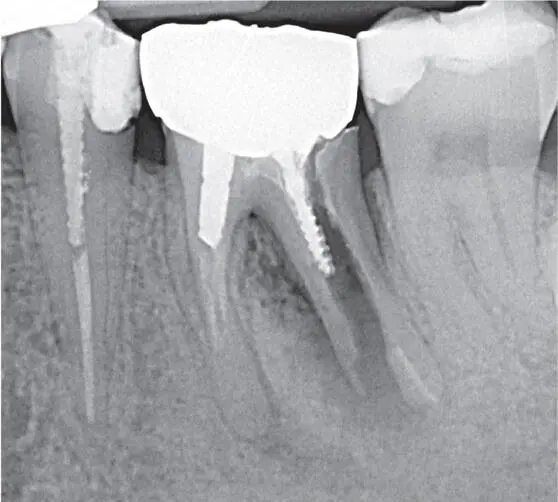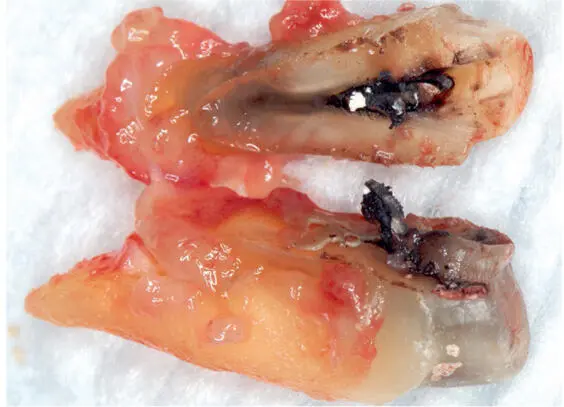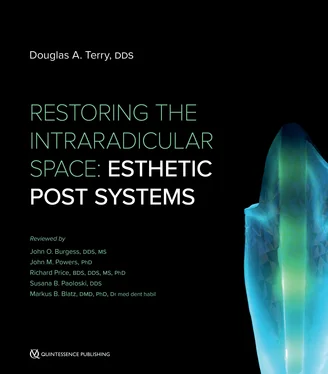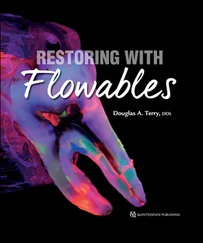Resistance to catastrophic root failure
Root fracture is another reason for failure of the post and core system.127 ,152 ,164 ,184 The primary goal of restoring ETT is to develop a design that distributes occlusal stress uniformly while preserving the tooth structure if the restoration fails during occlusal stress or dental trauma. Traditional cast posts (ie, stainless steel, chrome cobalt) have a modulus of elasticity as high as 10 times greater than that of natural dentin 55 ,350; however, an exception is titanium. This possible incompatibility can create stress concentrations in the less rigid root, resulting in post separation or failure.170 –172 ,206 ,351 –353 Additionally, the transmission of occlusal forces through the metal core can focus stresses at specific regions of the root and have been implicated in the high incidence of vertical root fracture 55 ,185 ,354 ( Fig 1-11). The fiber-reinforced composite post consists of fibers embedded in a polymeric matrix, and this combination creates a stiffness behavior for the post system that is similar to root dentin (elastic modulus of 18 GPa), which preserves the natural flexibility of the tooth. In addition, this similarity in elastic modulus between the fiber post and dentin reduces stress concentrations and restores stress distributions that are similar to the sound tooth.185 In the sound tooth, stress is more uniform. 20 ,355 ,356 Because fiber posts exhibit a modulus of elasticity similar to that of root dentin,206 ,357 the applied forces are more evenly distributed along the length of the post,206 ,358 which minimizes the stress concentrations and reduces the potential risk for catastrophic root fracture. 29 , 95 ,206 ,359 –366 Numerous stress analysis studies conclude that ETT restored with fiber-reinforced composite posts have lower and more favorably distributed stresses than do teeth with metal posts. 111 ,355 ,367 –372 Therefore, the fiber-reinforced composite post has a negligible incidence of root fracture118 ,201 ,356 ,361 ,373 ,374; however, only laboratory tests show a difference in root fracture when metal or zirconia posts are used compared to fiber posts. The adhesive interface with different elastic moduli, such as with a metal post system and dentin, represents the weakest point of the restorative system.351 ,356 ,375 ,376 Thus, fiber posts with mechanical properties similar to root dentin induce lower stresses than metal posts at the interface,114 ,206 and their clinical performance is considered more favorable because of their favorable fracture mode 69 ,201 and reduced root fracture.361 ,365 ,377 –379

Fig 1-11 Vertical root fracture in a mandibular first molar resulting from stresses caused by occlusal forces through the metal core of the post.
Fractures in ETT with fiber-reinforced posts usually occur in the cervical region, whereas metal posts have demonstrated a more apically positioned fracture. 111 ,361 ,362 ,366 ,379 One study of different post systems reported that teeth restored with posts had properties similar to those of sound tooth structure. Glass fiber posts demonstrated favorable fractures, whereas those restored with zirconia and titanium posts demonstrated catastrophic fractures.353 Those that were considered favorable fractures exhibited failure patterns that allowed for endodontic retreatment and/or repreparation380 of the existing restored tooth and occurred more frequently in the cervical third.356 ,381 ,382 Also, studies indicate that dentin-bonded resin post-core restorations provided significantly less resistance to failure than the cemented custom-cast post and core and that the dentin-bonded resin post and core fractured in every instance before the roots fractured.383
Furthermore, an important factor in the structural design is the fail-safe feature that allows retrievability of the fiber-reinforced composite post. Unlike ceramic post systems, this material is less difficult to remove from the canal with a low- or high-speed diamond bur or an ultrasonic instrument for endodontic and/or restorative retreatment 42 ,384 ,385 without the risk of root perforation. One study reported that fractures occurring with the use of glass fiber or quartz posts were repairable, whereas fractures that occurred with titanium or zirconia posts were irreparable.353 Therefore, significant factors that affect resistance to root fracture should be considered, such as the biomechanical behavior of the material, occlusal stress patterns, eliminating stress at the interface of components of the system, 44preservation and protection of tooth tissue, and the use of an adhesive design concept. Additionally, forces that act on endodontically treated restored teeth can cause failure during mastication. 54
Differences in the biomechanical behavior of anterior and posterior teeth should be considered due to the different force directions each receive.386 ,387 Posterior teeth receive compressive loads that are vectored in an occlusogingival or vertical direction, whereas anterior teeth receive flexural stresses that are vectored in a horizontal or lateral direction. 69 ,388 ,389 Masticatory loads usually generate compressive stresses, while fatigue fractures are generally caused by tensile stresses and not compression. 45 ,125 ,201 These lateral tensile stresses generally are more destructive to the tooth-restorative interface and occur in the anterior region. 69 ,377 Therefore, consideration should be taken of the occlusal scheme (ie, canine or group function, type of occlusion, overjet and overbite) according to tooth location to determine the potential risk for failure. Horizontal forces generated by parafunction may increase the risk of failure to ETT.388 ,389 To minimize the magnitude of stresses, the occlusal design should allow occlusal points of contact while minimizing wider areas of contact.388 ,390 ,391 Furthermore, occlusal interferences should be continuously evaluated and equilibrated periodically because these forces can be potentially damaging.388 ,392
Lack of corrosiveness
The combination of noble and non-noble alloys in the oral environment may result in electrochemical reactions such as corrosion of metals.121 This can result in destruction and breakdown of these materials and can also cause interaction between the biologic host environment and the released corrosion products.393 On the other hand, titanium posts form a passive oxide layer so the post does not corrode. Traditional prefabricated posts are made of metal alloys, and root fracture has been attributed to corrosion products resulting from possible galvanic activity 19 , 79 ,121 ,169 ,394 between an amalgam core and the stainless steel or brass in posts. 7 ,152 These non-noble metals can be subjected to corrosion in biologic and nonbiologic environments such as the oral cavity. 19 ,167 ,395 These corrosion mechanisms can be multifactorial including low available oxygen, microbial biofilms, and electrical potentials that occur in the oral environment. 19 ,396 Corrosion expansion stresses can occur from these mechanisms when in a confined space such as the intraradicular channel and result in expansion from a wedging effect that can subsequently result in root fracture 19 ,397 ( Fig 1-12). To avert these corrosion expansion stresses, traditional post systems that have metals of different electrochemical potential should not be utilized for intraradicular rehabilitation. 19Thus, another structural design benefit that adds to the applicability of the fiber-reinforced composite system is their high corrosion resistance 79and the biocompatibility of the restorative materials.

Fig 1-12 Root fracture occurred in this maxillary premolar as a result of corrosion of a non-noble metal alloy post.
Читать дальше














